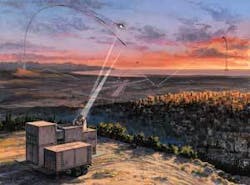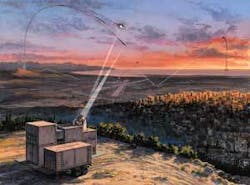Northrop Grumman proposes high-energy ground laser to defend commercial aircraft
By John McHale
REDONDO BEACH, Calif. - Northrop Grumman Corp. proposed a ground-based, high-energy laser system called Skyguard as part of a layered airport defense to protect commercial jetliners from terrorists firing shoulder-fired missiles.
The layered defense proposal from Northrop Grumman Space Technology in Redondo Beach, Calif., includes the jamming laser onboard jetliners, as well as the high-energy ground laser that can shoot down missile threats known as man-portable air defense systems (MANPADs).
The company submitted its proposal to the U.S. Department of Homeland Security Science and Technology Directorate, Counter-MANPADs System Program Office, which is conducting a program to evaluate and demonstrate emerging technologies in defeating the MANPAD threats to commercial aviation.
“Northrop Grumman is developing a range of approaches to provide a layered defense for airport security,” says Alexis Livanos, president of Northrop Grumman’s Space Technology sector. Livanos says Northrop Grumman is suited to this application based on its aircraft-based Directional Infrared Countermeasure (DIRCM) system, “which the Department of Homeland Security is currently evaluating, in addition to the ground-based, high-energy laser system we proposed.”
In the near term, DIRCM can be installed on the most vulnerable aircraft, company officials say. As the threat of attack continues to increase and new, more capable types of threat systems are introduced, however, Northrop Grumman experts say a layered defense can substantially help mitigate the danger to commercial aviation.
Skyguard uses a high-energy laser to destroy a wide range of anti-aircraft threats in the airport region, even with very short launch ranges, says Mike McVey, vice president of Directed Energy Systems for Northrop Grumman. He says that Skyguard technology is the only proven and tested non-DIRCM solution and is available in less than two years once a contract is received at approximately $30 million for each system. The initial system will cost approximately $150 million.
Skyguard’s capabilities will be based on Northrop Grumman technology demonstrated at the Tactical High Energy Laser (THEL) testbed at White Sands Missile Range, N.M. Northrop Grumman developed the THEL test bed for the U.S. Army and the Israel Ministry of Defense.
The proposed Skyguard system has speed-of-light operation, extreme precision, proven lethality, and operational safety, McVey says. He notes that THEL has shot down dozens of rockets in flight since 2000, including 122-millimeter Katyusha rockets, short-range ballistic missiles, artillery, and several calibers of mortars.
Compatible with a range of packaging options, the Skyguard laser system would be placed at or near an airport to detect, track, and destroy a variety of threats. This capability would handle infrared seeker systems, and also is effective against command-guided missiles and other threats known to be in growing terrorist inventories, McVey adds.
Before the Counter-MANPADS proposal Northrop Grumman officials also announced a Skyguard proposal for the U.S. military. The proposed military system would provide near-term defense against short-range ballistic missiles, short- and long-range rockets, artillery shells, mortars, unmanned aerial vehicles, and cruise missiles.
Like earlier Northrop Grumman systems, Skyguard is a multimission, soldier-operated, compact and transportable laser weapon system designed for field deployment and operations. One Skyguard system can defend deployed forces, a large military installation, and/or a large civilian population or industrial area under a protective shield about six miles wide
“The THEL testbed has demonstrated unequivocally that lasers can engage and destroy rocket, artillery, and mortar threats in flight,” McVey says. “This testbed has been remarkably successful. To date, it has shot down dozens of live threats, including long- and short-range rockets, mortars, and artillery projectiles, in very realistic attack scenarios, and under simulated operational conditions such as surprise attacks and mixed threats.”
Like the THEL testbed, Skyguard is a modular and flexible system that will support future spiral developments and can accommodate improved laser and beam-control technologies as they become available.
Skyguard will be approximately one- quarter the size of THEL and be more powerful and more efficient, a Northrop Grumman spokesperson says. The greater efficiency will come from a more efficient fuel magazine enabling more shots fired per magazine, he adds.
While Skyguard will not be mobile by the Army’s definition, it can be moved by truck, but is semistationary and off the truck during operation, the spokesman says. It is moved in three standard 20-by-8-foot containers, he adds.
Under the Department of Defense’s Technology Readiness Level, Skyguard is at level 6, with level 9 representing technology that is ready to be fielded, the spokesman says.
The Department of Homeland Security stated that the approaches it will evaluate in this procurement are limited to ground-based systems and aircraft-borne non-DIRCM systems. These will involve alternative approaches employing emerging technologies that may have the potential for defeating MANPADs in a layered defense environment.
Congress has funded the Department of Homeland Security (DHS) to assess alternative approaches to the current onboard DIRCM system demonstration currently under way. DH S officials will soon be awarding the next stage of the Counter-MANPADS contract, Northrop Grumman’s spokesman says.

